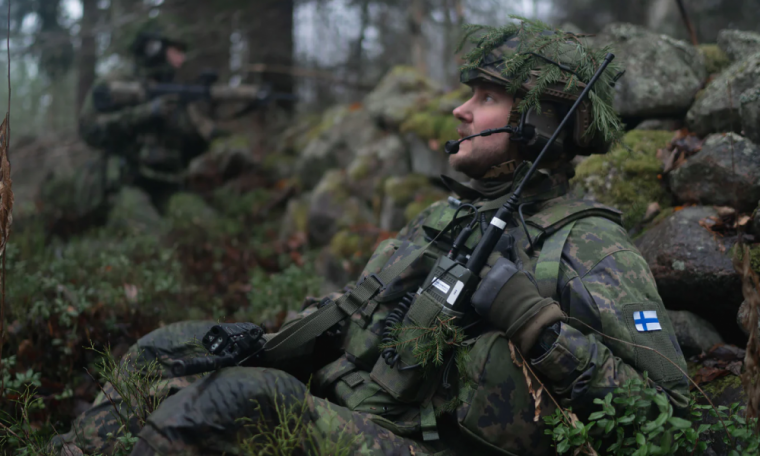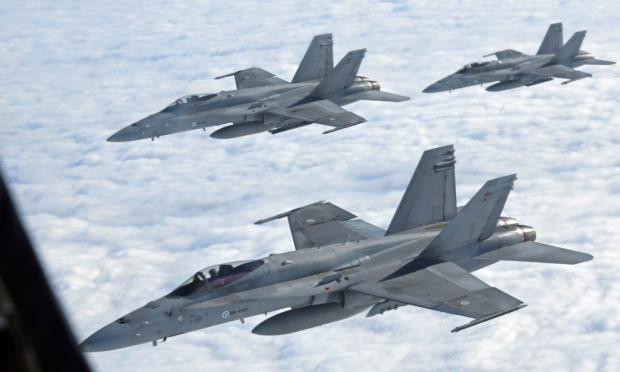Finland's accession to NATO in April marked Helsinki's historic shift away from decades of security neutrality in the Euro-Atlantic bloc. Russia's invasion of Ukraine in February 2022 triggered a major shift in public and political opinion in favour of NATO membership. The same happened in Sweden, which is still waiting for final approval to join the alliance.
As tensions between Russia and NATO continue, Eurofighter Typhoons of the British Royal Air Force (RAF) have been moved to a forward base in Finland for training with Finnish F/A-18 Hornet fighters under the "Joutsen Strike" exercise.
The Typhoon FGR4 aircraft, already stationed at Amari Air Base in Estonia for the NATO Baltic Air Policing exercise, were reportedly deployed to Tampere Air Base in Finland. This is significant as Finland became the 31st member of NATO, despite repeated Russian warnings against the alliance's expansion.
According to information provided by the RAF, Finnish Air Force F-18 Hornet aircraft and British Typhoon fighters were involved in key fighter manoeuvres. "This element of the Exercise highlighted the RAF's ability to effectively engage and defeat adversaries at peer level," the RAF noted.
The Joint Expeditionary Force, also known as JEF, is a UK-led force comprising 10 NATO members from northern Europe: Denmark, Estonia, Estonia, Iceland, Latvia, Lithuania, Latvia, Lithuania, the Netherlands, Sweden, Norway, Finland and the United Kingdom. Its mission is to support regional security.
The Joutsen Strike exercise allowed the RAF and their Finnish counterparts to assess their planning capabilities and their aircrews and ground personnel, to exchange best practices and improve procedures. It also mimicked the type of response the JEF might be called upon to undertake in an emergency.
These exercises are not the first to receive direct Finnish participation since Finland joined NATO. In late May, Finland hosted the "Northern Forest" exercises, in which all NATO members pledged to protect their newest member against all possible security threats.
The latest exercises, however, come at a time of heightened military tensions between Russia and NATO in recent days, as military aid continues to flow into Ukraine.
To note, the two sides are nearing an unwarranted escalation. Last month, Ukraine crossed the red line when it first struck Crimea with the UK-supplied Storm Shadow long-range cruise missile. In retaliation, Russia struck Ukraine's port of Rennie on the Danube, near the NATO state of Romania.
Although military observers stressed that, a confrontation between Russian forces and NATO is "far-fetched", both sides have prepared for it. For example, Russia is upgrading its military and introducing newer upgrades to its fighter jets to counter the ever-present threat.
Russian United Aircraft Corporation, recently delivered a new batch of upgraded MiG-31 fighters to the Russian Ministry of Defense to base these jets at their permanent airfields. Not only that, Russia has also threatened to increase its military activity near the border with Finland.

In mid-May this year, satellite images of the Olenya airbase on Russia's Kola Peninsula revealed that some 16 strategic bombers had been deployed to this airbase near the NATO countries of Finland and Norway.
In addition, for its part, Russia has pledged to "strengthen its military potential" along its border with Finland. Russia's Deputy Foreign Minister Alexander Grusko said: "If forces and resources of other NATO members are deployed in Finland, we will take additional measures to reliably ensure Russia's military security."
The Russian invasion of Ukraine changed Finland's territorial security logic. Not only has the country (which declared neutrality) joined NATO, but it has also "opened" its territory to NATO.
Access to these new territories and their infrastructure allows the allies to monitor and contain Moscow and an unprecedented opportunity to treat northwestern Europe as a bloc.
As a reminder, Finland completed the $9.4 billion purchase of 64 Lockheed Martin F-35s and support services by signing a letter of offer and acceptance last year. Deliveries will be completed before 2030.

In addition, the US State Department is said to have authorized a proposed Foreign Military Sale (FMS) to Finland to purchase an M270A2 Multiple Launch Rocket System (MLRS) upgrade and related equipment. The purchase will cost approximately $395 million to the Finnish command.
A day after joining the alliance, Finland announced that it would purchase the US-Israeli long-range air defense system David's Sling for 316 million euros (US$345 million). This purchase, attributed to Finland's attempt to deter Russia in view of intensified Russian military activity near Finland's border.
Following Finland's NATO membership, Kremlin spokesman Dmitry Peskov warned that Russia would "closely monitor" what was happening in Finland, describing NATO expansion as a "violation of our security and national interests."
Finland has a 1,340-kilometre border with Russia.




